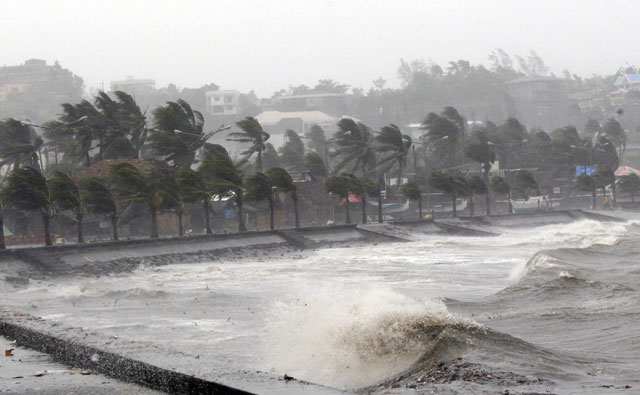LEGAZPI, Philippines — Typhoon Hagupit knocked out power, left at least three people dead and sent nearly 900,000 into shelters before it weakened Sunday, sparing the central Philippines the type of massive devastation that a monster storm brought to the region last year.
Shallow floods, damaged shanties and ripped off store signs and tin roofs were a common sight across the region, but there was no major destruction after Hagupit slammed into Eastern Samar and other island provinces. It was packing maximum sustained winds of 140 kilometres per hour (kph) and gusts of 170kph on Sunday, considerably weaker from its peak power but still a potentially deadly storm, according to forecasters.
The typhoon, which made landfall in Eastern Samar late Saturday, was moving slowly, dumping heavy rain that could possibly trigger landslides and flash floods.
Traumatised by the death and destruction from Typhoon Haiyan last year, nearly 900,000 people fled to about 1,000 emergency shelters and safer grounds. The government, backed by the 120,000-strong military, had launched massive preparations to attain a zero-casualty target.
Rhea Estuna, a 29-year-old mother of one, fled Thursday to an evacuation centre in Tacloban — the city hardest-hit by Haiyan — and waited in fear as Hagupit's wind and rain lashed the school where she and her family sought refuge. When she peered outside Sunday, she said she saw a starkly different aftermath than the one she witnessed after Haiyan struck in November 2013.
"There were no bodies scattered on the road, no big mounds of debris," Estuna told The Associated Press by cellphone. "Thanks to God this typhoon wasn't as violent."
Haiyan's tsunami-like storm surges and killer winds left thousands of people dead and leveled entire villages, most of them in and around Tacloban.
Nearly a dozen countries, led by the United States and the European Union, have pledged to help in case of a catastrophe from Hagupit (pronounced HA'-goo-pit), disaster-response agency chief Alexander Pama said.
The EU commissioner for humanitarian aid, Christos Stylianides, said a team of experts would be deployed to help assess the damage and needed response.
"The Philippines are not alone as they brace up for a possible hardship," Stylianides said, adding that the European Commission was "hoping that the impact will be less powerful than a year ago, when Typhoon Haiyan left a devastating imprint on the country".
Two people, including a baby girl, died of hypothermia in central Iloilo province Saturday at the height of the typhoon, Pama said at a news conference. Another person died after being hit by a falling tree in the eastern town of Dolores, where the typhoon first made landfall, according to Interior Secretary Mar Roxas.
Two women were injured when the tricycle taxi they were riding was struck by a falling tree in central Negros Oriental province.
Displaced villagers were asked to return home from emergency shelters in provinces where the danger posed by the typhoon had waned, including Albay, where more than half a million people were advised to leave evacuation sites.
Nearly 12,000 villagers, however, will remain in government shelters in Albay because their homes lie near a restive volcano.
While officials expressed relief that the typhoon had not caused major damage, they were quick to warn that Hagupit — Filipino for "smash" or "lash" — was still on course to barrel across three major central Philippine islands before starting to blow away Tuesday into the South China Sea.
